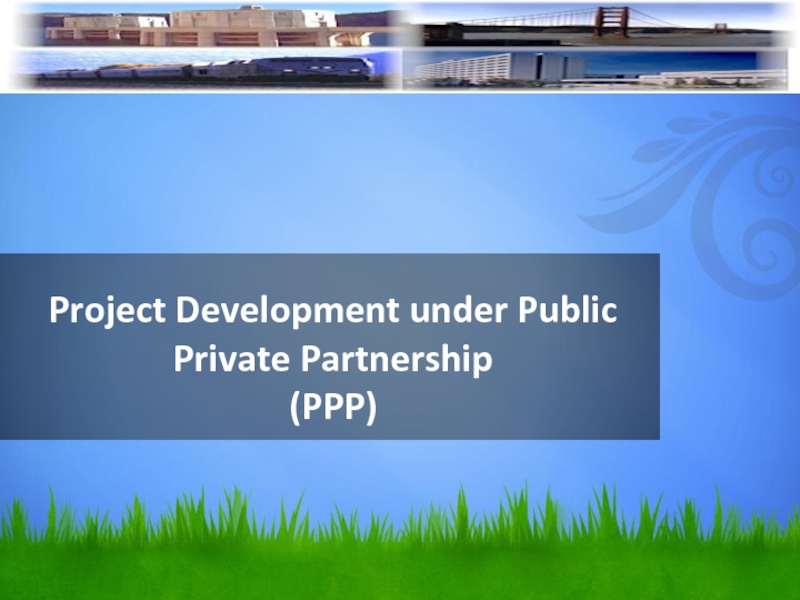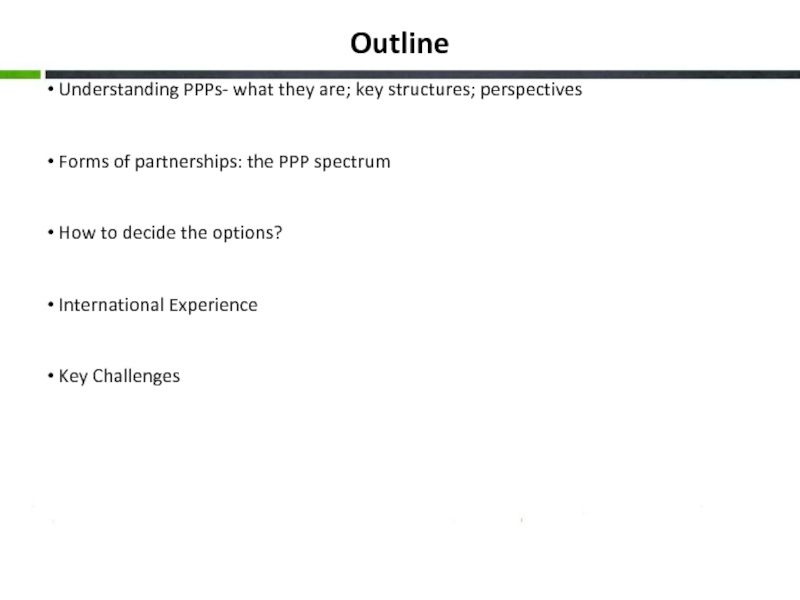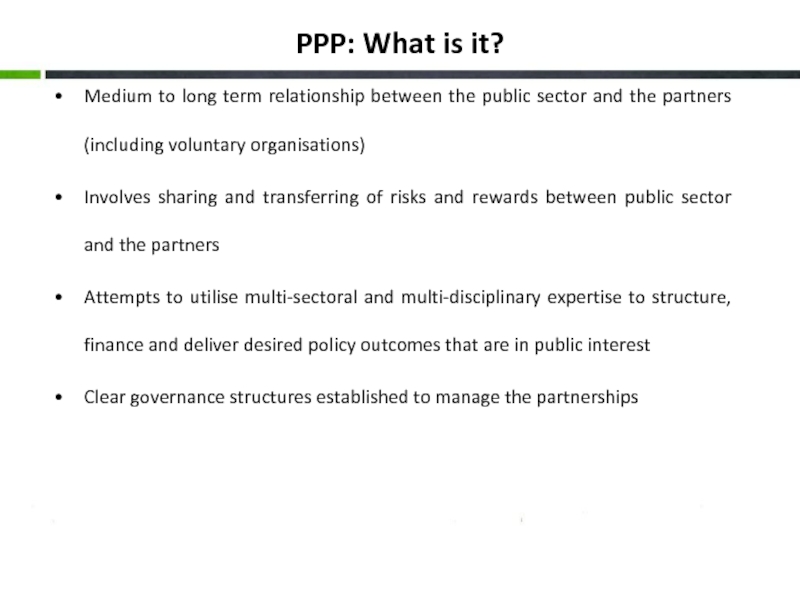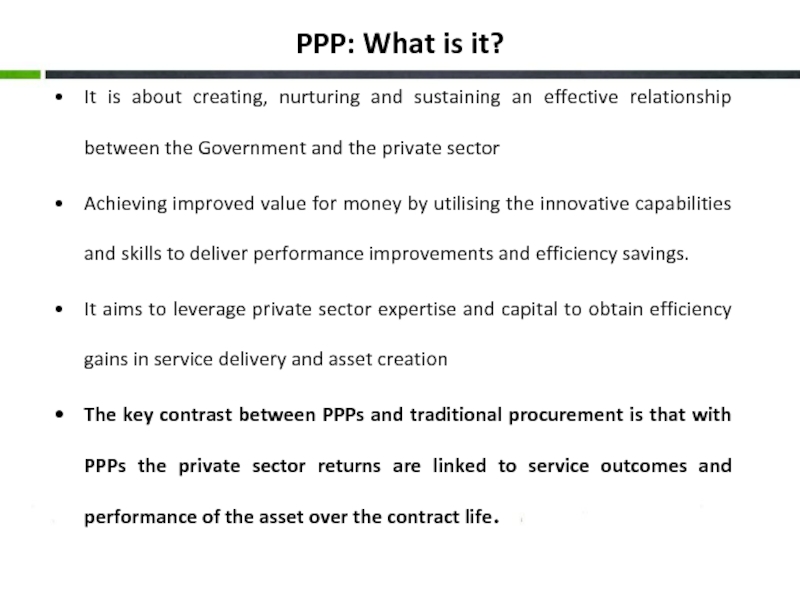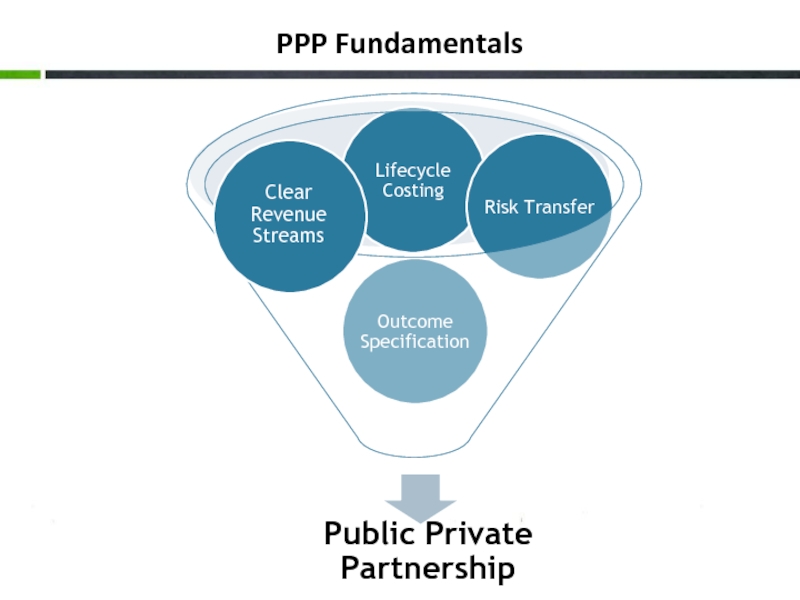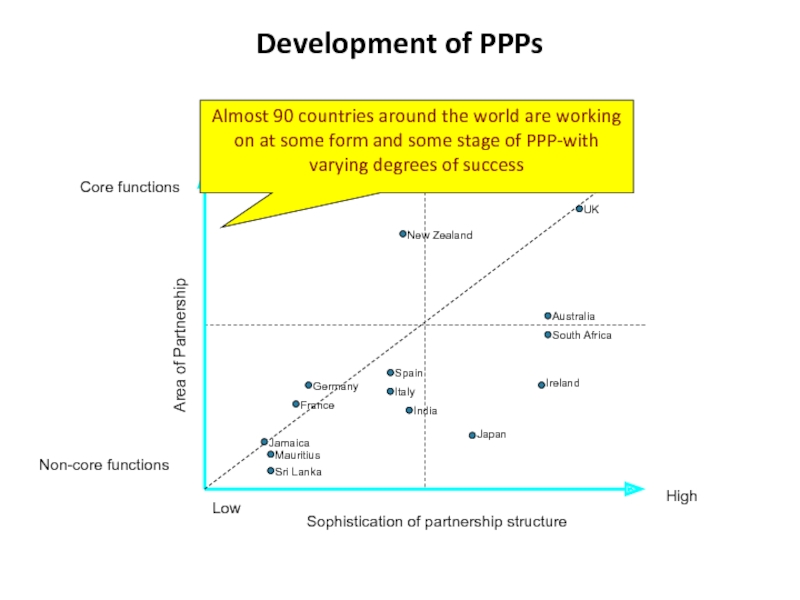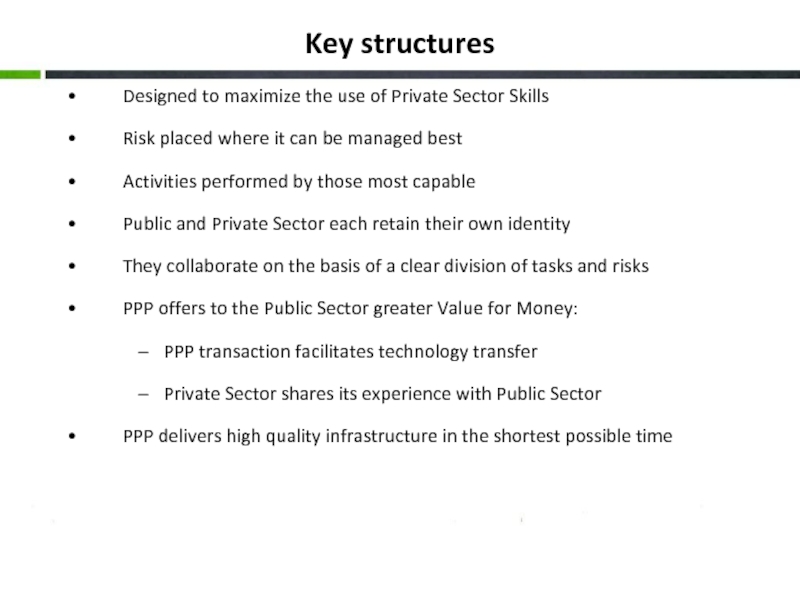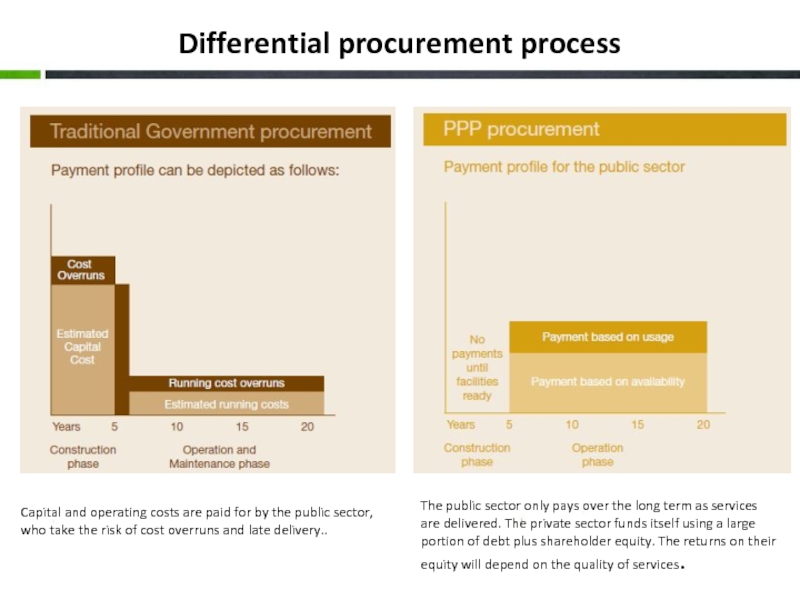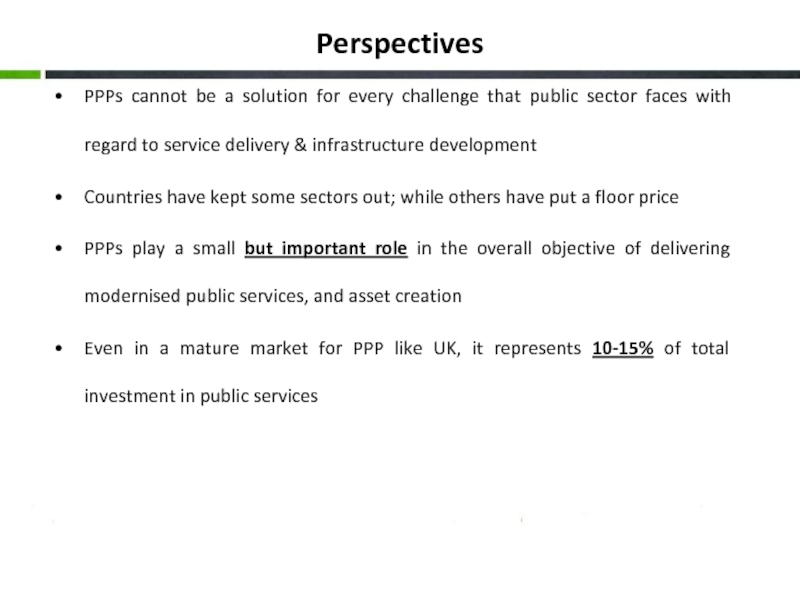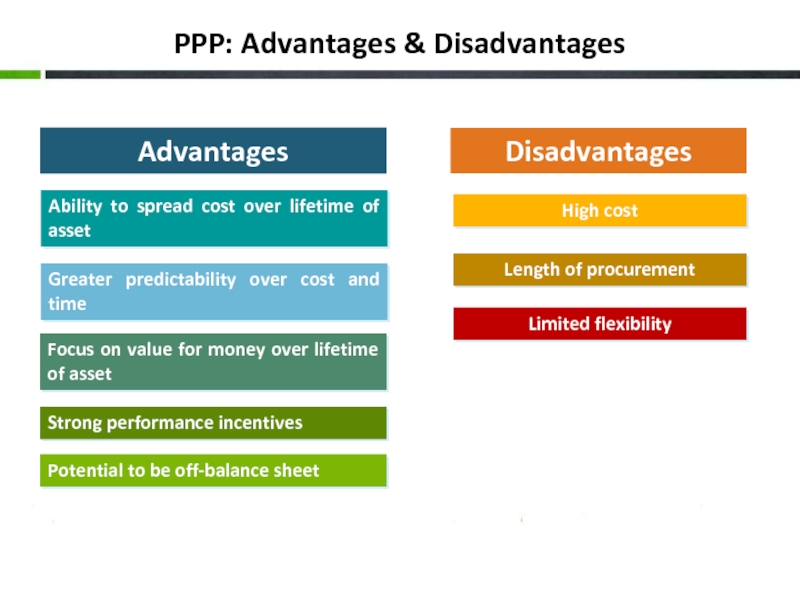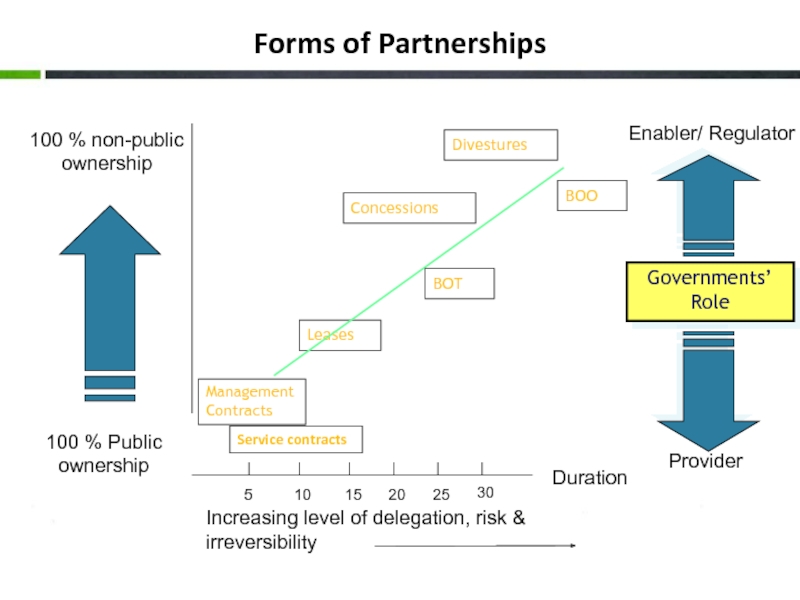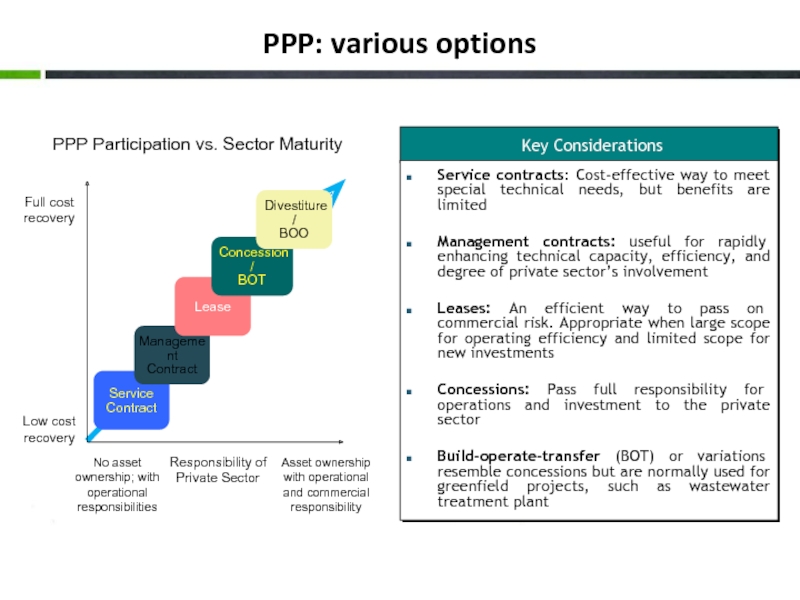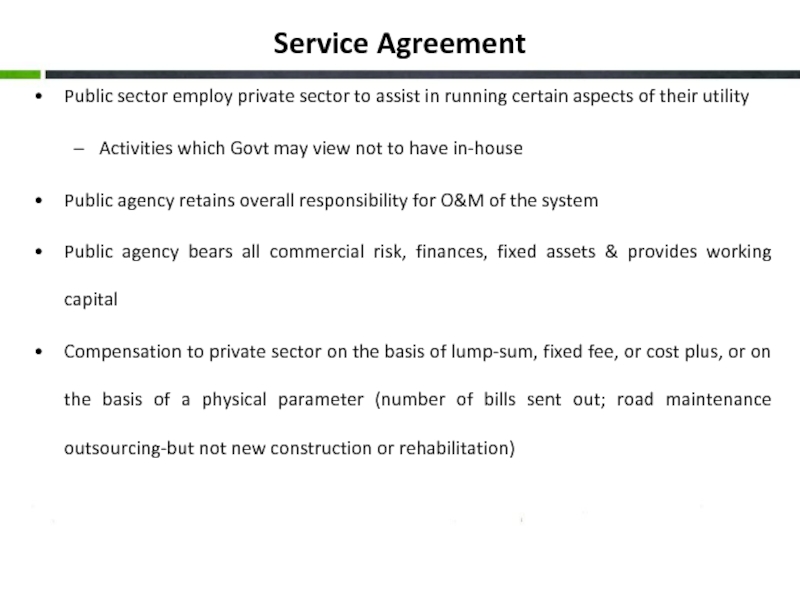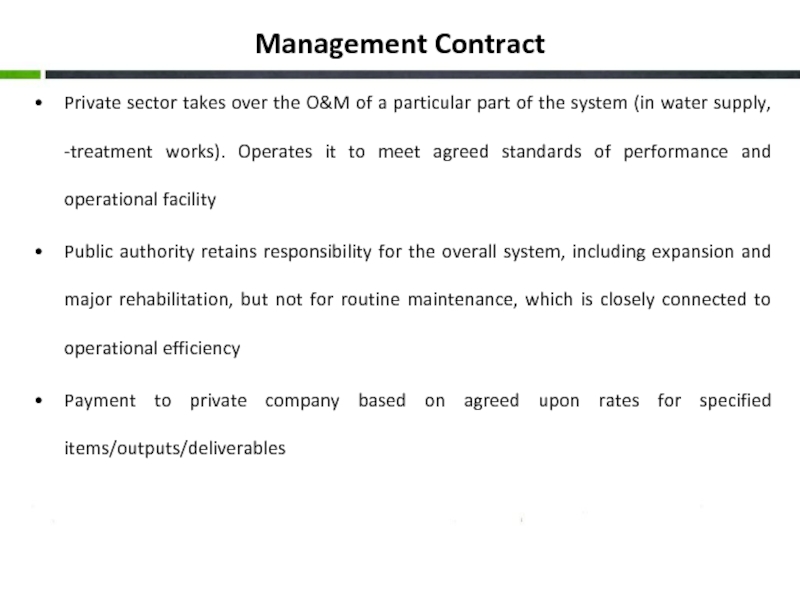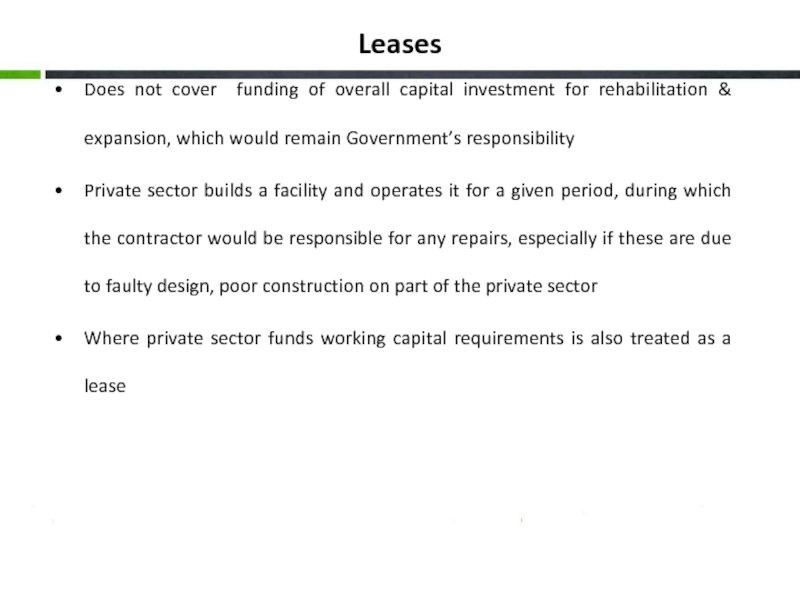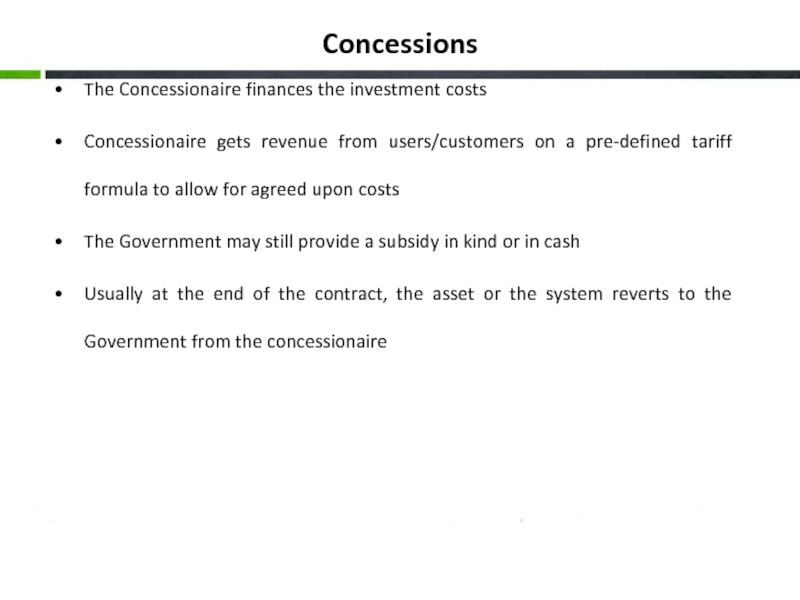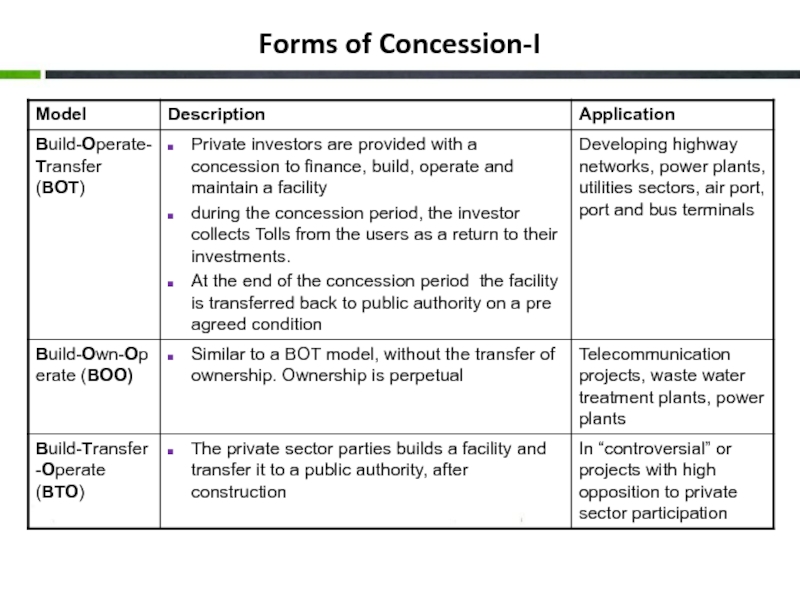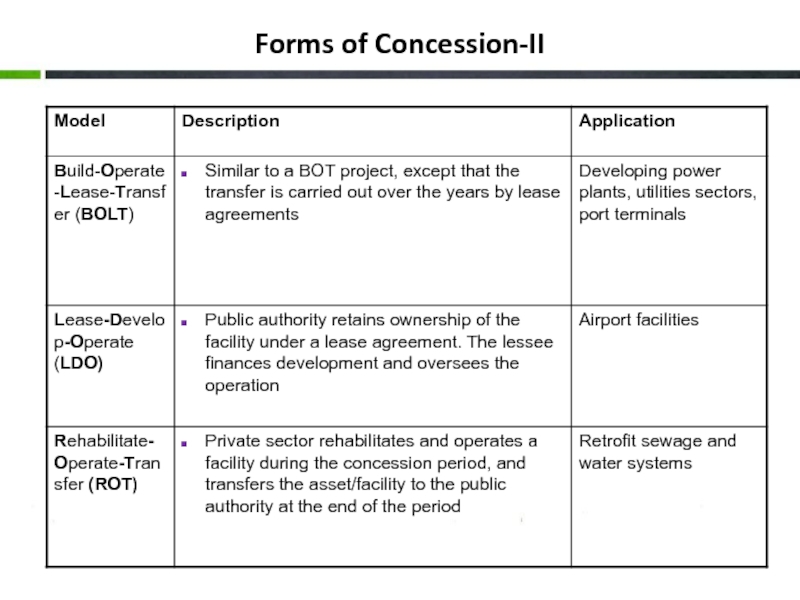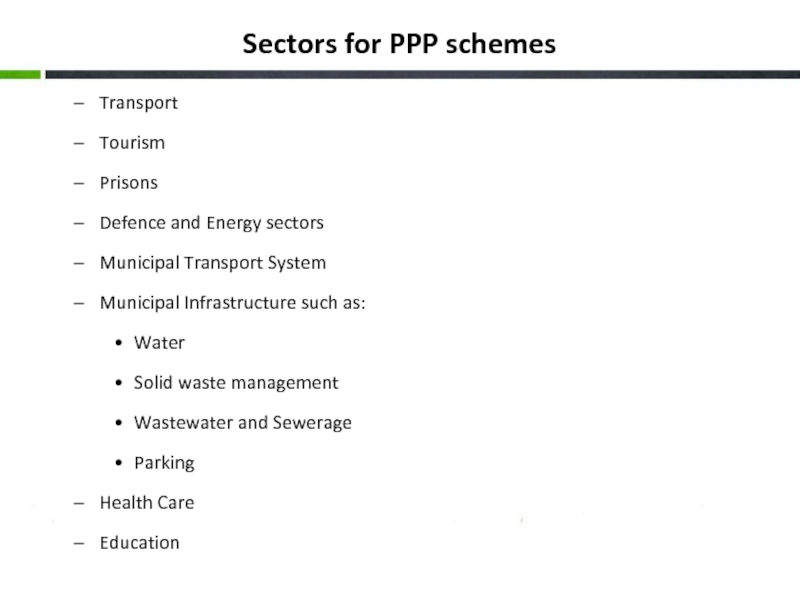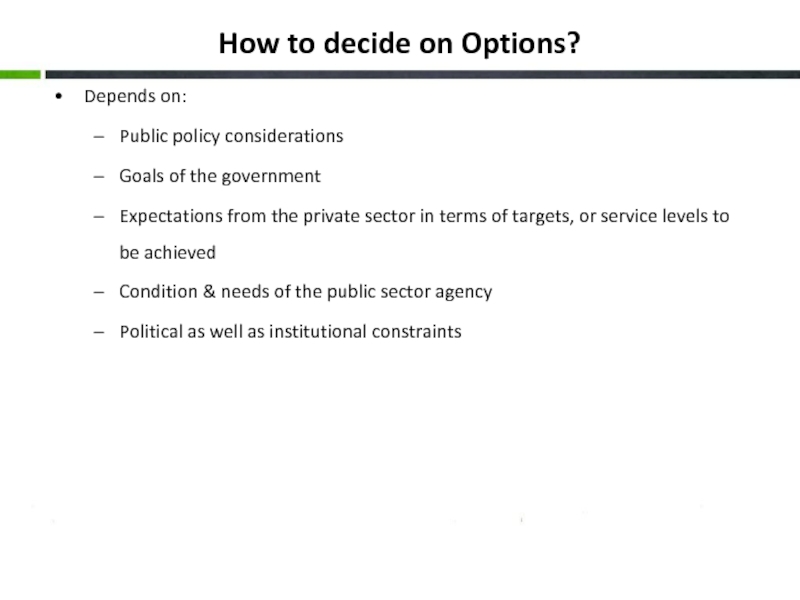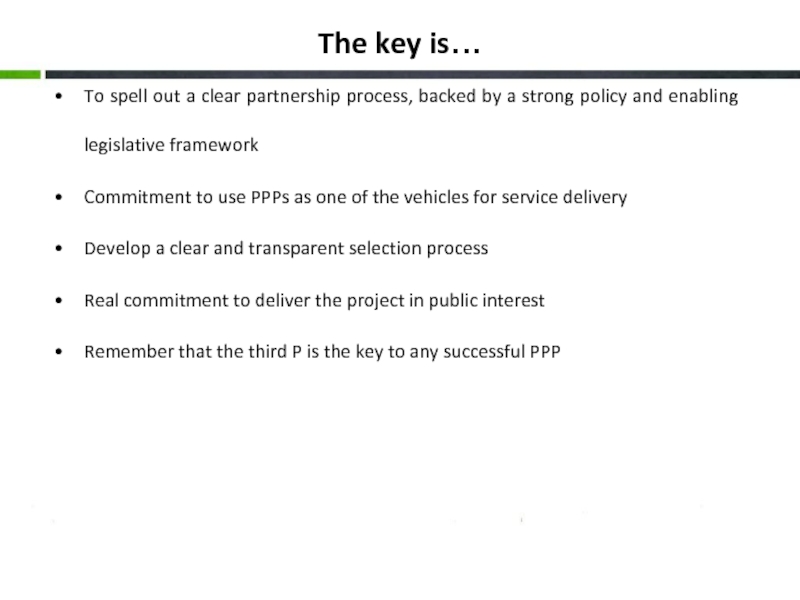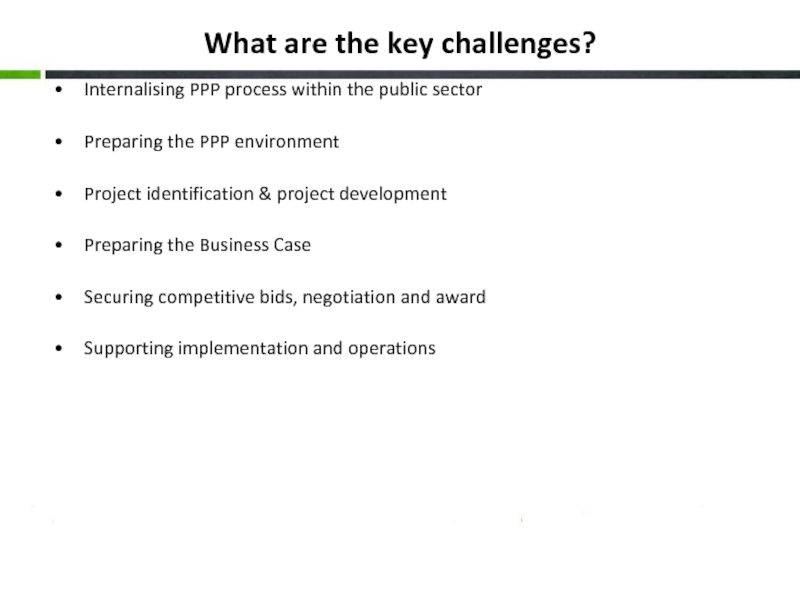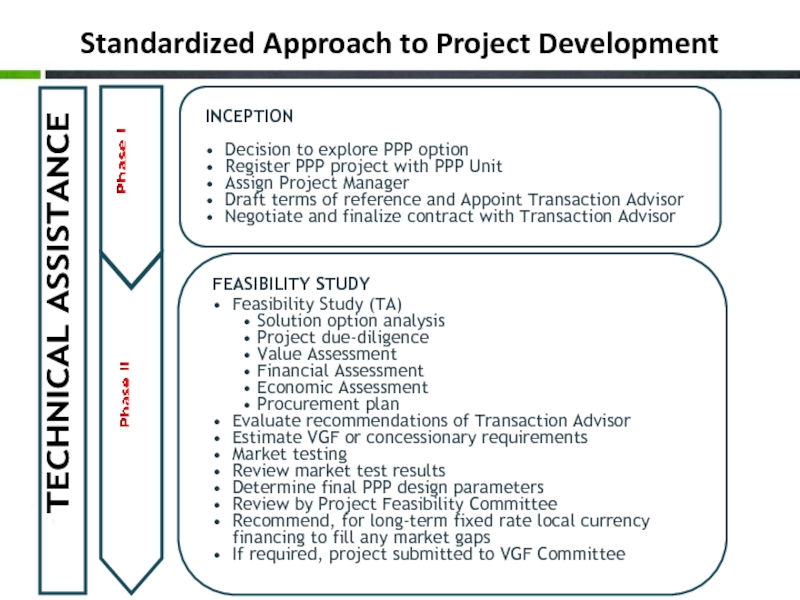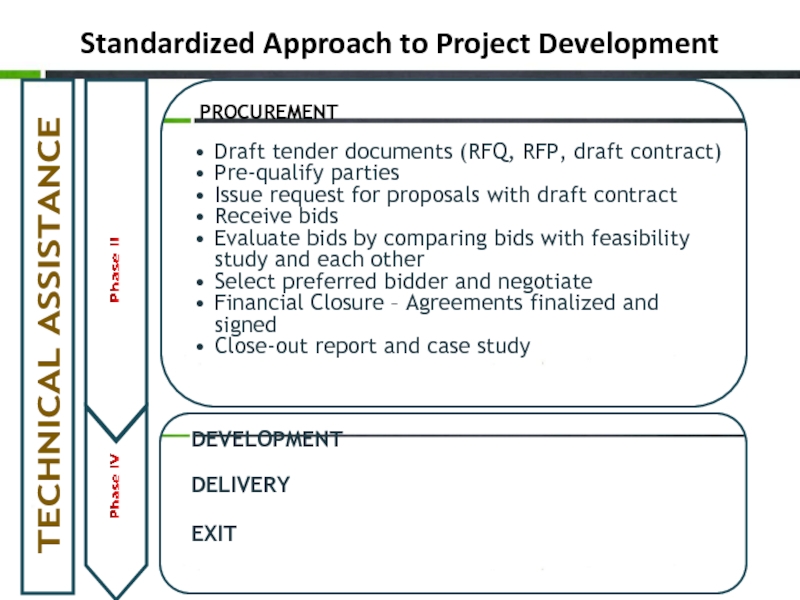- Главная
- Разное
- Дизайн
- Бизнес и предпринимательство
- Аналитика
- Образование
- Развлечения
- Красота и здоровье
- Финансы
- Государство
- Путешествия
- Спорт
- Недвижимость
- Армия
- Графика
- Культурология
- Еда и кулинария
- Лингвистика
- Английский язык
- Астрономия
- Алгебра
- Биология
- География
- Детские презентации
- Информатика
- История
- Литература
- Маркетинг
- Математика
- Медицина
- Менеджмент
- Музыка
- МХК
- Немецкий язык
- ОБЖ
- Обществознание
- Окружающий мир
- Педагогика
- Русский язык
- Технология
- Физика
- Философия
- Химия
- Шаблоны, картинки для презентаций
- Экология
- Экономика
- Юриспруденция
Project Development under Public Private Partnership (PPP) презентация
Содержание
- 1. Project Development under Public Private Partnership (PPP)
- 2. Outline Understanding PPPs- what they are;
- 3. PPP: What is it? Medium to long
- 4. PPP: What is it? It is about
- 5. PPP Fundamentals
- 6. Development of PPPs Sophistication of partnership
- 7. Key structures Designed to maximize the use
- 8. Differential procurement process Capital and operating costs
- 9. Perspectives PPPs cannot be a solution for
- 10. PPP: Advantages & Disadvantages Advantages Disadvantages Ability
- 11. Forms of Partnerships Duration Increasing level
- 12. PPP: various options PPP Participation vs.
- 13. Service Agreement Public sector employ private sector
- 14. Management Contract Private sector takes over the
- 15. Leases Does not cover funding of overall
- 16. Concessions The Concessionaire finances the investment costs
- 17. Forms of Concession-I
- 18. Forms of Concession-II
- 19. Sectors for PPP schemes Transport
- 20. How to decide on Options? Depends on:
- 21. The key is… To spell out a
- 22. What are the key challenges? Internalising PPP
- 23. Standardized Approach to Project Development TECHNICAL ASSISTANCE Phase II Phase I
- 24. Standardized Approach to Project Development DEVELOPMENT
- 25. Thanks & Questions
Слайд 2Outline
Understanding PPPs- what they are; key structures; perspectives
Forms of
How to decide the options?
International Experience
Key Challenges
Слайд 3PPP: What is it?
Medium to long term relationship between the public
Involves sharing and transferring of risks and rewards between public sector and the partners
Attempts to utilise multi-sectoral and multi-disciplinary expertise to structure, finance and deliver desired policy outcomes that are in public interest
Clear governance structures established to manage the partnerships
Слайд 4PPP: What is it?
It is about creating, nurturing and sustaining an
Achieving improved value for money by utilising the innovative capabilities and skills to deliver performance improvements and efficiency savings.
It aims to leverage private sector expertise and capital to obtain efficiency gains in service delivery and asset creation
The key contrast between PPPs and traditional procurement is that with PPPs the private sector returns are linked to service outcomes and performance of the asset over the contract life.
Слайд 6Development of PPPs
Sophistication of partnership structure
Low
High
Area of Partnership
Non-core functions
Core functions
France
Germany
Italy
Spain
Japan
Ireland
South Africa
Australia
New
UK
Almost 90 countries around the world are working on at some form and some stage of PPP-with varying degrees of success
India
Mauritius
Jamaica
Sri Lanka
Слайд 7Key structures
Designed to maximize the use of Private Sector Skills
Risk placed
Activities performed by those most capable
Public and Private Sector each retain their own identity
They collaborate on the basis of a clear division of tasks and risks
PPP offers to the Public Sector greater Value for Money:
PPP transaction facilitates technology transfer
Private Sector shares its experience with Public Sector
PPP delivers high quality infrastructure in the shortest possible time
Слайд 8Differential procurement process
Capital and operating costs are paid for by the
The public sector only pays over the long term as services are delivered. The private sector funds itself using a large portion of debt plus shareholder equity. The returns on their equity will depend on the quality of services.
Слайд 9Perspectives
PPPs cannot be a solution for every challenge that public sector
Countries have kept some sectors out; while others have put a floor price
PPPs play a small but important role in the overall objective of delivering modernised public services, and asset creation
Even in a mature market for PPP like UK, it represents 10-15% of total investment in public services
Слайд 10PPP: Advantages & Disadvantages
Advantages
Disadvantages
Ability to spread cost over lifetime of asset
Greater
Focus on value for money over lifetime of asset
Strong performance incentives
Potential to be off-balance sheet
High cost
Limited flexibility
Length of procurement
Слайд 11Forms of Partnerships
Duration
Increasing level of delegation, risk & irreversibility
Service contracts
Management Contracts
Leases
Concessions
Divestures
100
100 % Public ownership
5
10
15
20
25
30
BOT
BOO
Governments’ Role
Provider
Enabler/ Regulator
Слайд 12PPP: various options
PPP Participation vs. Sector Maturity
Responsibility of
Private Sector
Asset
No asset ownership; with operational responsibilities
Low cost recovery
Full cost recovery
Service
Contract
Management
Contract
Lease
Concession /
BOT
Divestiture /
BOO
Key Considerations
Service contracts: Cost-effective way to meet special technical needs, but benefits are limited
Management contracts: useful for rapidly enhancing technical capacity, efficiency, and degree of private sector’s involvement
Leases: An efficient way to pass on commercial risk. Appropriate when large scope for operating efficiency and limited scope for new investments
Concessions: Pass full responsibility for operations and investment to the private sector
Build-operate-transfer (BOT) or variations resemble concessions but are normally used for greenfield projects, such as wastewater treatment plant
Слайд 13Service Agreement
Public sector employ private sector to assist in running certain
Activities which Govt may view not to have in-house
Public agency retains overall responsibility for O&M of the system
Public agency bears all commercial risk, finances, fixed assets & provides working capital
Compensation to private sector on the basis of lump-sum, fixed fee, or cost plus, or on the basis of a physical parameter (number of bills sent out; road maintenance outsourcing-but not new construction or rehabilitation)
Слайд 14Management Contract
Private sector takes over the O&M of a particular part
Public authority retains responsibility for the overall system, including expansion and major rehabilitation, but not for routine maintenance, which is closely connected to operational efficiency
Payment to private company based on agreed upon rates for specified items/outputs/deliverables
Слайд 15Leases
Does not cover funding of overall capital investment for rehabilitation &
Private sector builds a facility and operates it for a given period, during which the contractor would be responsible for any repairs, especially if these are due to faulty design, poor construction on part of the private sector
Where private sector funds working capital requirements is also treated as a lease
Слайд 16Concessions
The Concessionaire finances the investment costs
Concessionaire gets revenue from users/customers on
The Government may still provide a subsidy in kind or in cash
Usually at the end of the contract, the asset or the system reverts to the Government from the concessionaire
Слайд 19
Sectors for PPP schemes
Transport
Tourism
Prisons
Defence and Energy sectors
Municipal Transport System
Municipal Infrastructure such
Water
Solid waste management
Wastewater and Sewerage
Parking
Health Care
Education
Слайд 20How to decide on Options?
Depends on:
Public policy considerations
Goals of the government
Expectations
Condition & needs of the public sector agency
Political as well as institutional constraints
Слайд 21The key is…
To spell out a clear partnership process, backed by
Commitment to use PPPs as one of the vehicles for service delivery
Develop a clear and transparent selection process
Real commitment to deliver the project in public interest
Remember that the third P is the key to any successful PPP
Слайд 22What are the key challenges?
Internalising PPP process within the public sector
Preparing
Project identification & project development
Preparing the Business Case
Securing competitive bids, negotiation and award
Supporting implementation and operations
Слайд 24Standardized Approach to Project Development
DEVELOPMENT
DELIVERY
EXIT
PROCUREMENT
Draft tender documents (RFQ, RFP,
Pre-qualify parties
Issue request for proposals with draft contract
Receive bids
Evaluate bids by comparing bids with feasibility study and each other
Select preferred bidder and negotiate
Financial Closure – Agreements finalized and signed
Close-out report and case study
TECHNICAL ASSISTANCE
Phase II
Phase IV
